Clinical Management Plan and Session Plan for Joe.
VerifiedAdded on 2022/11/13
|15
|3957
|3
AI Summary
Contribute Materials
Your contribution can guide someone’s learning journey. Share your
documents today.

Running head: CLINICAL MANAGEMENT PLAN AND SESSION PLAN FOR JOE 1
Clinical Management Plan and Session Plan for Joe
Name
Institutional Affiliation
Clinical Management Plan and Session Plan for Joe
Name
Institutional Affiliation
Secure Best Marks with AI Grader
Need help grading? Try our AI Grader for instant feedback on your assignments.
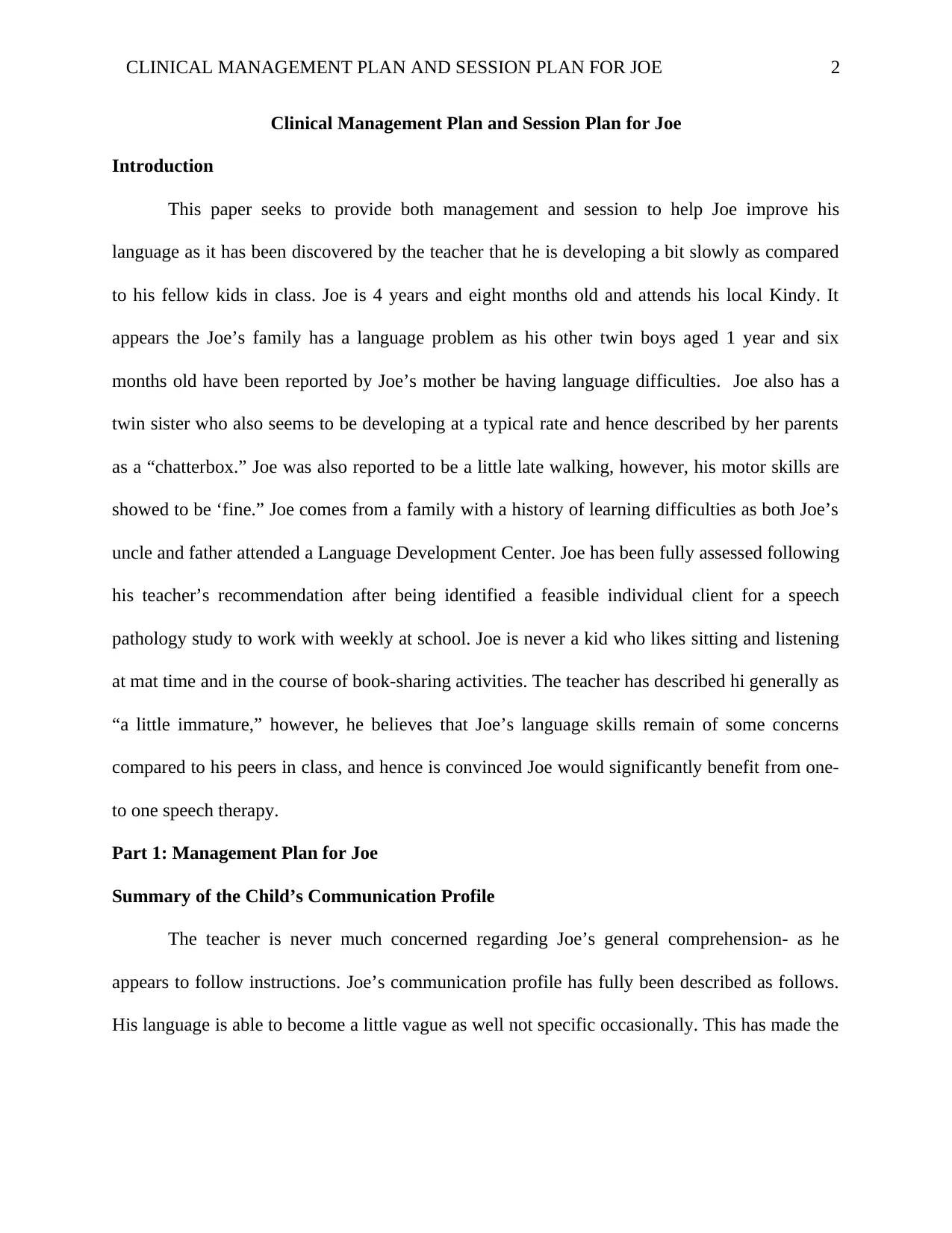
CLINICAL MANAGEMENT PLAN AND SESSION PLAN FOR JOE 2
Clinical Management Plan and Session Plan for Joe
Introduction
This paper seeks to provide both management and session to help Joe improve his
language as it has been discovered by the teacher that he is developing a bit slowly as compared
to his fellow kids in class. Joe is 4 years and eight months old and attends his local Kindy. It
appears the Joe’s family has a language problem as his other twin boys aged 1 year and six
months old have been reported by Joe’s mother be having language difficulties. Joe also has a
twin sister who also seems to be developing at a typical rate and hence described by her parents
as a “chatterbox.” Joe was also reported to be a little late walking, however, his motor skills are
showed to be ‘fine.” Joe comes from a family with a history of learning difficulties as both Joe’s
uncle and father attended a Language Development Center. Joe has been fully assessed following
his teacher’s recommendation after being identified a feasible individual client for a speech
pathology study to work with weekly at school. Joe is never a kid who likes sitting and listening
at mat time and in the course of book-sharing activities. The teacher has described hi generally as
“a little immature,” however, he believes that Joe’s language skills remain of some concerns
compared to his peers in class, and hence is convinced Joe would significantly benefit from one-
to one speech therapy.
Part 1: Management Plan for Joe
Summary of the Child’s Communication Profile
The teacher is never much concerned regarding Joe’s general comprehension- as he
appears to follow instructions. Joe’s communication profile has fully been described as follows.
His language is able to become a little vague as well not specific occasionally. This has made the
Clinical Management Plan and Session Plan for Joe
Introduction
This paper seeks to provide both management and session to help Joe improve his
language as it has been discovered by the teacher that he is developing a bit slowly as compared
to his fellow kids in class. Joe is 4 years and eight months old and attends his local Kindy. It
appears the Joe’s family has a language problem as his other twin boys aged 1 year and six
months old have been reported by Joe’s mother be having language difficulties. Joe also has a
twin sister who also seems to be developing at a typical rate and hence described by her parents
as a “chatterbox.” Joe was also reported to be a little late walking, however, his motor skills are
showed to be ‘fine.” Joe comes from a family with a history of learning difficulties as both Joe’s
uncle and father attended a Language Development Center. Joe has been fully assessed following
his teacher’s recommendation after being identified a feasible individual client for a speech
pathology study to work with weekly at school. Joe is never a kid who likes sitting and listening
at mat time and in the course of book-sharing activities. The teacher has described hi generally as
“a little immature,” however, he believes that Joe’s language skills remain of some concerns
compared to his peers in class, and hence is convinced Joe would significantly benefit from one-
to one speech therapy.
Part 1: Management Plan for Joe
Summary of the Child’s Communication Profile
The teacher is never much concerned regarding Joe’s general comprehension- as he
appears to follow instructions. Joe’s communication profile has fully been described as follows.
His language is able to become a little vague as well not specific occasionally. This has made the
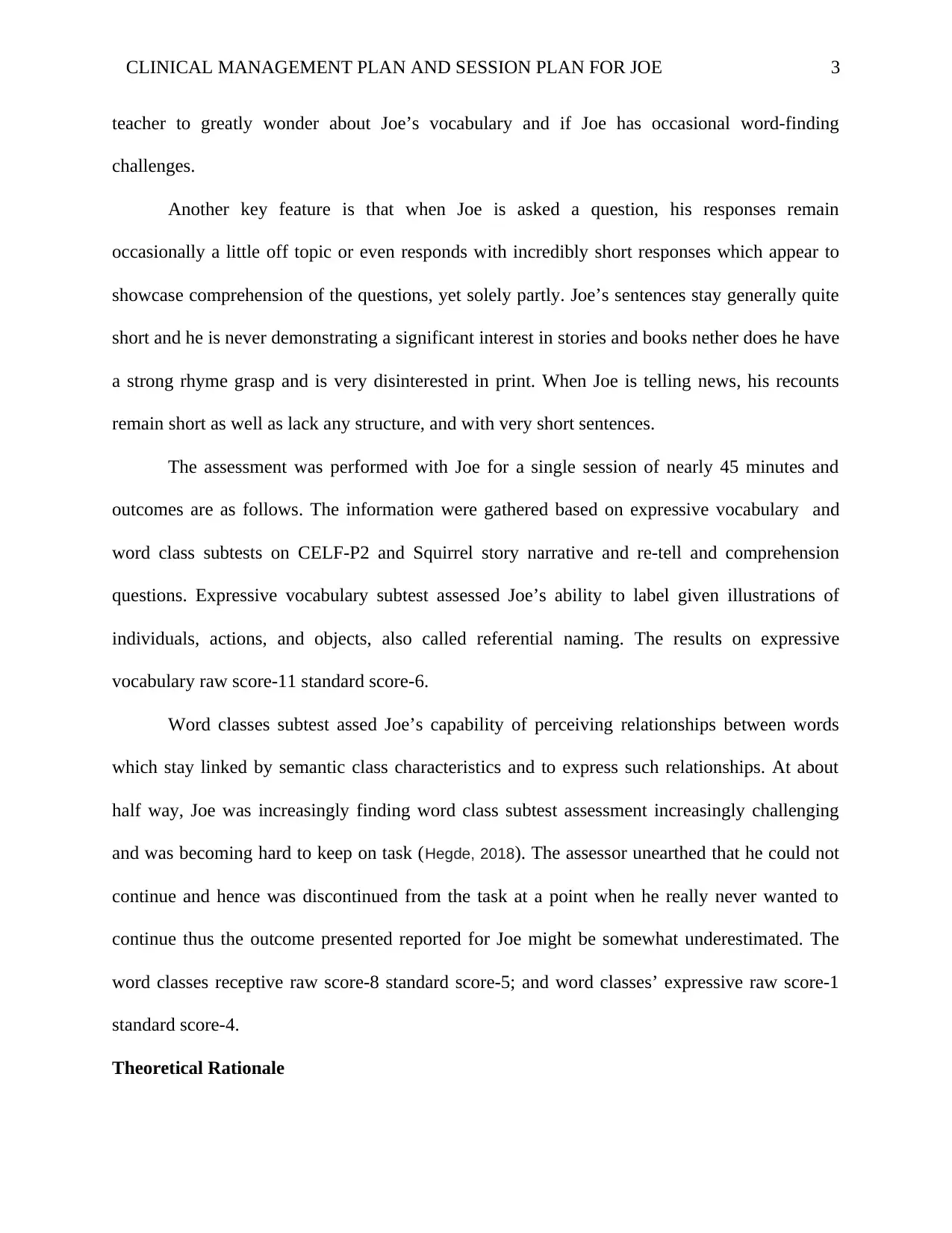
CLINICAL MANAGEMENT PLAN AND SESSION PLAN FOR JOE 3
teacher to greatly wonder about Joe’s vocabulary and if Joe has occasional word-finding
challenges.
Another key feature is that when Joe is asked a question, his responses remain
occasionally a little off topic or even responds with incredibly short responses which appear to
showcase comprehension of the questions, yet solely partly. Joe’s sentences stay generally quite
short and he is never demonstrating a significant interest in stories and books nether does he have
a strong rhyme grasp and is very disinterested in print. When Joe is telling news, his recounts
remain short as well as lack any structure, and with very short sentences.
The assessment was performed with Joe for a single session of nearly 45 minutes and
outcomes are as follows. The information were gathered based on expressive vocabulary and
word class subtests on CELF-P2 and Squirrel story narrative and re-tell and comprehension
questions. Expressive vocabulary subtest assessed Joe’s ability to label given illustrations of
individuals, actions, and objects, also called referential naming. The results on expressive
vocabulary raw score-11 standard score-6.
Word classes subtest assed Joe’s capability of perceiving relationships between words
which stay linked by semantic class characteristics and to express such relationships. At about
half way, Joe was increasingly finding word class subtest assessment increasingly challenging
and was becoming hard to keep on task (Hegde, 2018). The assessor unearthed that he could not
continue and hence was discontinued from the task at a point when he really never wanted to
continue thus the outcome presented reported for Joe might be somewhat underestimated. The
word classes receptive raw score-8 standard score-5; and word classes’ expressive raw score-1
standard score-4.
Theoretical Rationale
teacher to greatly wonder about Joe’s vocabulary and if Joe has occasional word-finding
challenges.
Another key feature is that when Joe is asked a question, his responses remain
occasionally a little off topic or even responds with incredibly short responses which appear to
showcase comprehension of the questions, yet solely partly. Joe’s sentences stay generally quite
short and he is never demonstrating a significant interest in stories and books nether does he have
a strong rhyme grasp and is very disinterested in print. When Joe is telling news, his recounts
remain short as well as lack any structure, and with very short sentences.
The assessment was performed with Joe for a single session of nearly 45 minutes and
outcomes are as follows. The information were gathered based on expressive vocabulary and
word class subtests on CELF-P2 and Squirrel story narrative and re-tell and comprehension
questions. Expressive vocabulary subtest assessed Joe’s ability to label given illustrations of
individuals, actions, and objects, also called referential naming. The results on expressive
vocabulary raw score-11 standard score-6.
Word classes subtest assed Joe’s capability of perceiving relationships between words
which stay linked by semantic class characteristics and to express such relationships. At about
half way, Joe was increasingly finding word class subtest assessment increasingly challenging
and was becoming hard to keep on task (Hegde, 2018). The assessor unearthed that he could not
continue and hence was discontinued from the task at a point when he really never wanted to
continue thus the outcome presented reported for Joe might be somewhat underestimated. The
word classes receptive raw score-8 standard score-5; and word classes’ expressive raw score-1
standard score-4.
Theoretical Rationale
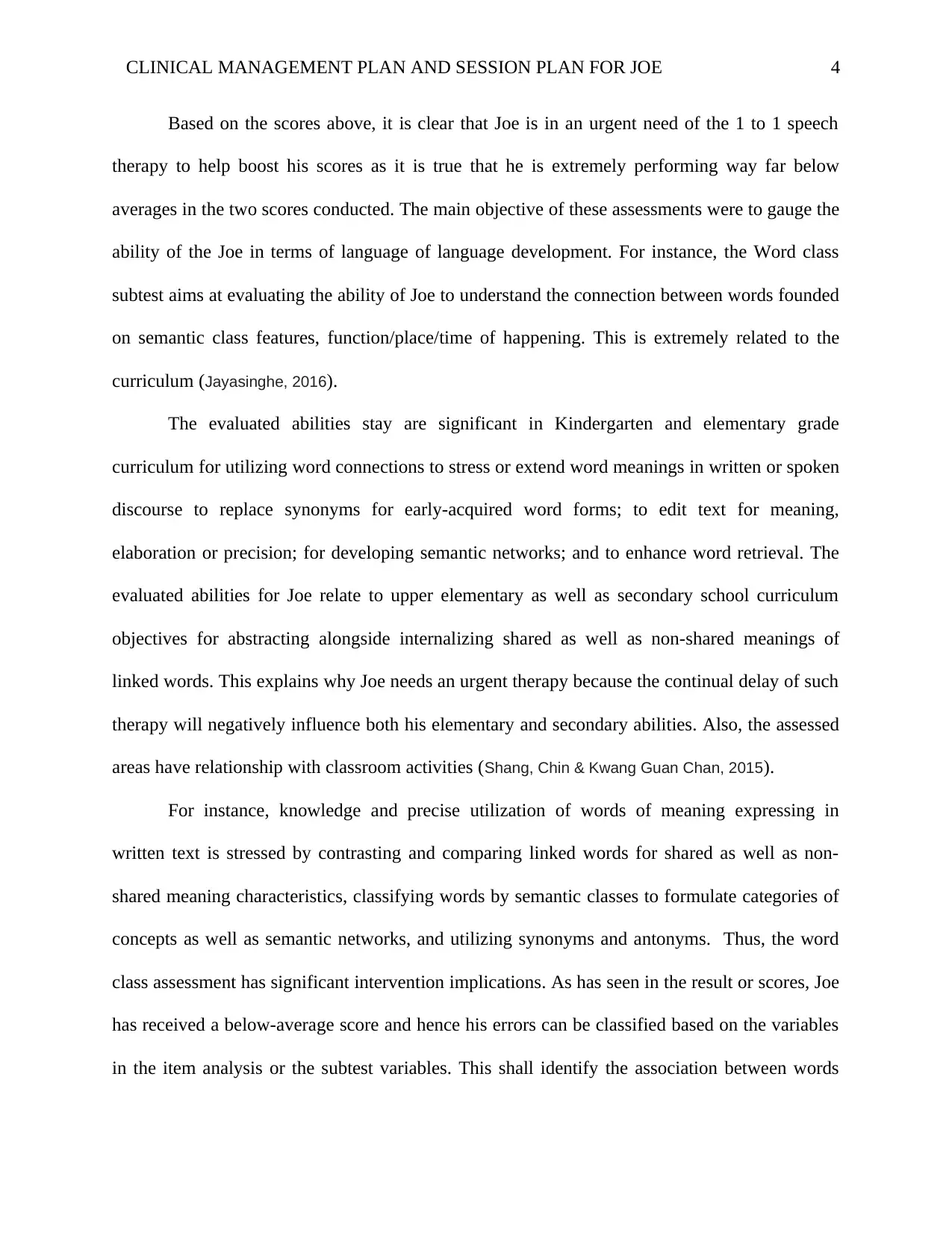
CLINICAL MANAGEMENT PLAN AND SESSION PLAN FOR JOE 4
Based on the scores above, it is clear that Joe is in an urgent need of the 1 to 1 speech
therapy to help boost his scores as it is true that he is extremely performing way far below
averages in the two scores conducted. The main objective of these assessments were to gauge the
ability of the Joe in terms of language of language development. For instance, the Word class
subtest aims at evaluating the ability of Joe to understand the connection between words founded
on semantic class features, function/place/time of happening. This is extremely related to the
curriculum (Jayasinghe, 2016).
The evaluated abilities stay are significant in Kindergarten and elementary grade
curriculum for utilizing word connections to stress or extend word meanings in written or spoken
discourse to replace synonyms for early-acquired word forms; to edit text for meaning,
elaboration or precision; for developing semantic networks; and to enhance word retrieval. The
evaluated abilities for Joe relate to upper elementary as well as secondary school curriculum
objectives for abstracting alongside internalizing shared as well as non-shared meanings of
linked words. This explains why Joe needs an urgent therapy because the continual delay of such
therapy will negatively influence both his elementary and secondary abilities. Also, the assessed
areas have relationship with classroom activities (Shang, Chin & Kwang Guan Chan, 2015).
For instance, knowledge and precise utilization of words of meaning expressing in
written text is stressed by contrasting and comparing linked words for shared as well as non-
shared meaning characteristics, classifying words by semantic classes to formulate categories of
concepts as well as semantic networks, and utilizing synonyms and antonyms. Thus, the word
class assessment has significant intervention implications. As has seen in the result or scores, Joe
has received a below-average score and hence his errors can be classified based on the variables
in the item analysis or the subtest variables. This shall identify the association between words
Based on the scores above, it is clear that Joe is in an urgent need of the 1 to 1 speech
therapy to help boost his scores as it is true that he is extremely performing way far below
averages in the two scores conducted. The main objective of these assessments were to gauge the
ability of the Joe in terms of language of language development. For instance, the Word class
subtest aims at evaluating the ability of Joe to understand the connection between words founded
on semantic class features, function/place/time of happening. This is extremely related to the
curriculum (Jayasinghe, 2016).
The evaluated abilities stay are significant in Kindergarten and elementary grade
curriculum for utilizing word connections to stress or extend word meanings in written or spoken
discourse to replace synonyms for early-acquired word forms; to edit text for meaning,
elaboration or precision; for developing semantic networks; and to enhance word retrieval. The
evaluated abilities for Joe relate to upper elementary as well as secondary school curriculum
objectives for abstracting alongside internalizing shared as well as non-shared meanings of
linked words. This explains why Joe needs an urgent therapy because the continual delay of such
therapy will negatively influence both his elementary and secondary abilities. Also, the assessed
areas have relationship with classroom activities (Shang, Chin & Kwang Guan Chan, 2015).
For instance, knowledge and precise utilization of words of meaning expressing in
written text is stressed by contrasting and comparing linked words for shared as well as non-
shared meaning characteristics, classifying words by semantic classes to formulate categories of
concepts as well as semantic networks, and utilizing synonyms and antonyms. Thus, the word
class assessment has significant intervention implications. As has seen in the result or scores, Joe
has received a below-average score and hence his errors can be classified based on the variables
in the item analysis or the subtest variables. This shall identify the association between words
Secure Best Marks with AI Grader
Need help grading? Try our AI Grader for instant feedback on your assignments.
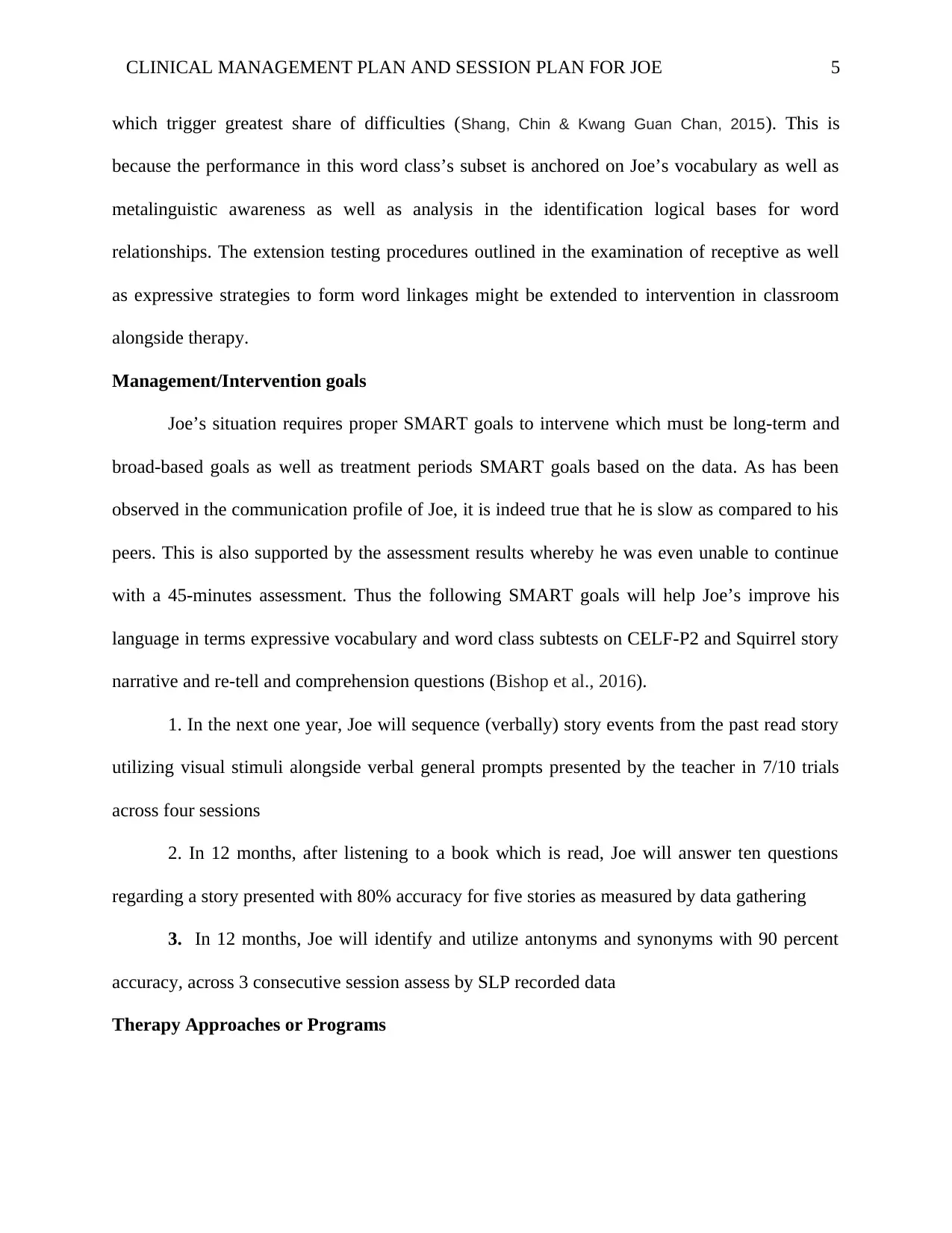
CLINICAL MANAGEMENT PLAN AND SESSION PLAN FOR JOE 5
which trigger greatest share of difficulties (Shang, Chin & Kwang Guan Chan, 2015). This is
because the performance in this word class’s subset is anchored on Joe’s vocabulary as well as
metalinguistic awareness as well as analysis in the identification logical bases for word
relationships. The extension testing procedures outlined in the examination of receptive as well
as expressive strategies to form word linkages might be extended to intervention in classroom
alongside therapy.
Management/Intervention goals
Joe’s situation requires proper SMART goals to intervene which must be long-term and
broad-based goals as well as treatment periods SMART goals based on the data. As has been
observed in the communication profile of Joe, it is indeed true that he is slow as compared to his
peers. This is also supported by the assessment results whereby he was even unable to continue
with a 45-minutes assessment. Thus the following SMART goals will help Joe’s improve his
language in terms expressive vocabulary and word class subtests on CELF-P2 and Squirrel story
narrative and re-tell and comprehension questions (Bishop et al., 2016).
1. In the next one year, Joe will sequence (verbally) story events from the past read story
utilizing visual stimuli alongside verbal general prompts presented by the teacher in 7/10 trials
across four sessions
2. In 12 months, after listening to a book which is read, Joe will answer ten questions
regarding a story presented with 80% accuracy for five stories as measured by data gathering
3. In 12 months, Joe will identify and utilize antonyms and synonyms with 90 percent
accuracy, across 3 consecutive session assess by SLP recorded data
Therapy Approaches or Programs
which trigger greatest share of difficulties (Shang, Chin & Kwang Guan Chan, 2015). This is
because the performance in this word class’s subset is anchored on Joe’s vocabulary as well as
metalinguistic awareness as well as analysis in the identification logical bases for word
relationships. The extension testing procedures outlined in the examination of receptive as well
as expressive strategies to form word linkages might be extended to intervention in classroom
alongside therapy.
Management/Intervention goals
Joe’s situation requires proper SMART goals to intervene which must be long-term and
broad-based goals as well as treatment periods SMART goals based on the data. As has been
observed in the communication profile of Joe, it is indeed true that he is slow as compared to his
peers. This is also supported by the assessment results whereby he was even unable to continue
with a 45-minutes assessment. Thus the following SMART goals will help Joe’s improve his
language in terms expressive vocabulary and word class subtests on CELF-P2 and Squirrel story
narrative and re-tell and comprehension questions (Bishop et al., 2016).
1. In the next one year, Joe will sequence (verbally) story events from the past read story
utilizing visual stimuli alongside verbal general prompts presented by the teacher in 7/10 trials
across four sessions
2. In 12 months, after listening to a book which is read, Joe will answer ten questions
regarding a story presented with 80% accuracy for five stories as measured by data gathering
3. In 12 months, Joe will identify and utilize antonyms and synonyms with 90 percent
accuracy, across 3 consecutive session assess by SLP recorded data
Therapy Approaches or Programs
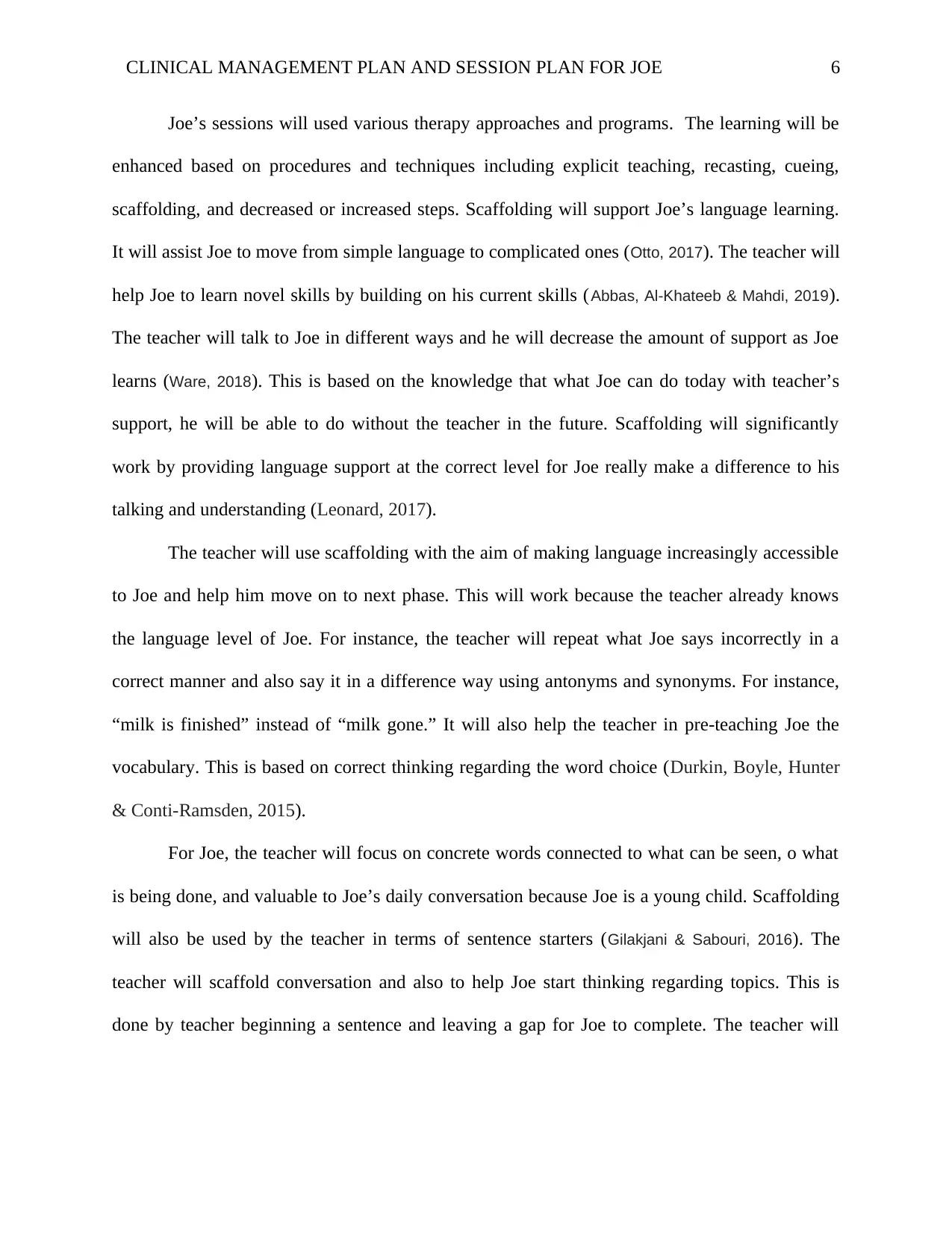
CLINICAL MANAGEMENT PLAN AND SESSION PLAN FOR JOE 6
Joe’s sessions will used various therapy approaches and programs. The learning will be
enhanced based on procedures and techniques including explicit teaching, recasting, cueing,
scaffolding, and decreased or increased steps. Scaffolding will support Joe’s language learning.
It will assist Joe to move from simple language to complicated ones (Otto, 2017). The teacher will
help Joe to learn novel skills by building on his current skills (Abbas, Al-Khateeb & Mahdi, 2019).
The teacher will talk to Joe in different ways and he will decrease the amount of support as Joe
learns (Ware, 2018). This is based on the knowledge that what Joe can do today with teacher’s
support, he will be able to do without the teacher in the future. Scaffolding will significantly
work by providing language support at the correct level for Joe really make a difference to his
talking and understanding (Leonard, 2017).
The teacher will use scaffolding with the aim of making language increasingly accessible
to Joe and help him move on to next phase. This will work because the teacher already knows
the language level of Joe. For instance, the teacher will repeat what Joe says incorrectly in a
correct manner and also say it in a difference way using antonyms and synonyms. For instance,
“milk is finished” instead of “milk gone.” It will also help the teacher in pre-teaching Joe the
vocabulary. This is based on correct thinking regarding the word choice (Durkin, Boyle, Hunter
& Conti-Ramsden, 2015).
For Joe, the teacher will focus on concrete words connected to what can be seen, o what
is being done, and valuable to Joe’s daily conversation because Joe is a young child. Scaffolding
will also be used by the teacher in terms of sentence starters (Gilakjani & Sabouri, 2016). The
teacher will scaffold conversation and also to help Joe start thinking regarding topics. This is
done by teacher beginning a sentence and leaving a gap for Joe to complete. The teacher will
Joe’s sessions will used various therapy approaches and programs. The learning will be
enhanced based on procedures and techniques including explicit teaching, recasting, cueing,
scaffolding, and decreased or increased steps. Scaffolding will support Joe’s language learning.
It will assist Joe to move from simple language to complicated ones (Otto, 2017). The teacher will
help Joe to learn novel skills by building on his current skills (Abbas, Al-Khateeb & Mahdi, 2019).
The teacher will talk to Joe in different ways and he will decrease the amount of support as Joe
learns (Ware, 2018). This is based on the knowledge that what Joe can do today with teacher’s
support, he will be able to do without the teacher in the future. Scaffolding will significantly
work by providing language support at the correct level for Joe really make a difference to his
talking and understanding (Leonard, 2017).
The teacher will use scaffolding with the aim of making language increasingly accessible
to Joe and help him move on to next phase. This will work because the teacher already knows
the language level of Joe. For instance, the teacher will repeat what Joe says incorrectly in a
correct manner and also say it in a difference way using antonyms and synonyms. For instance,
“milk is finished” instead of “milk gone.” It will also help the teacher in pre-teaching Joe the
vocabulary. This is based on correct thinking regarding the word choice (Durkin, Boyle, Hunter
& Conti-Ramsden, 2015).
For Joe, the teacher will focus on concrete words connected to what can be seen, o what
is being done, and valuable to Joe’s daily conversation because Joe is a young child. Scaffolding
will also be used by the teacher in terms of sentence starters (Gilakjani & Sabouri, 2016). The
teacher will scaffold conversation and also to help Joe start thinking regarding topics. This is
done by teacher beginning a sentence and leaving a gap for Joe to complete. The teacher will
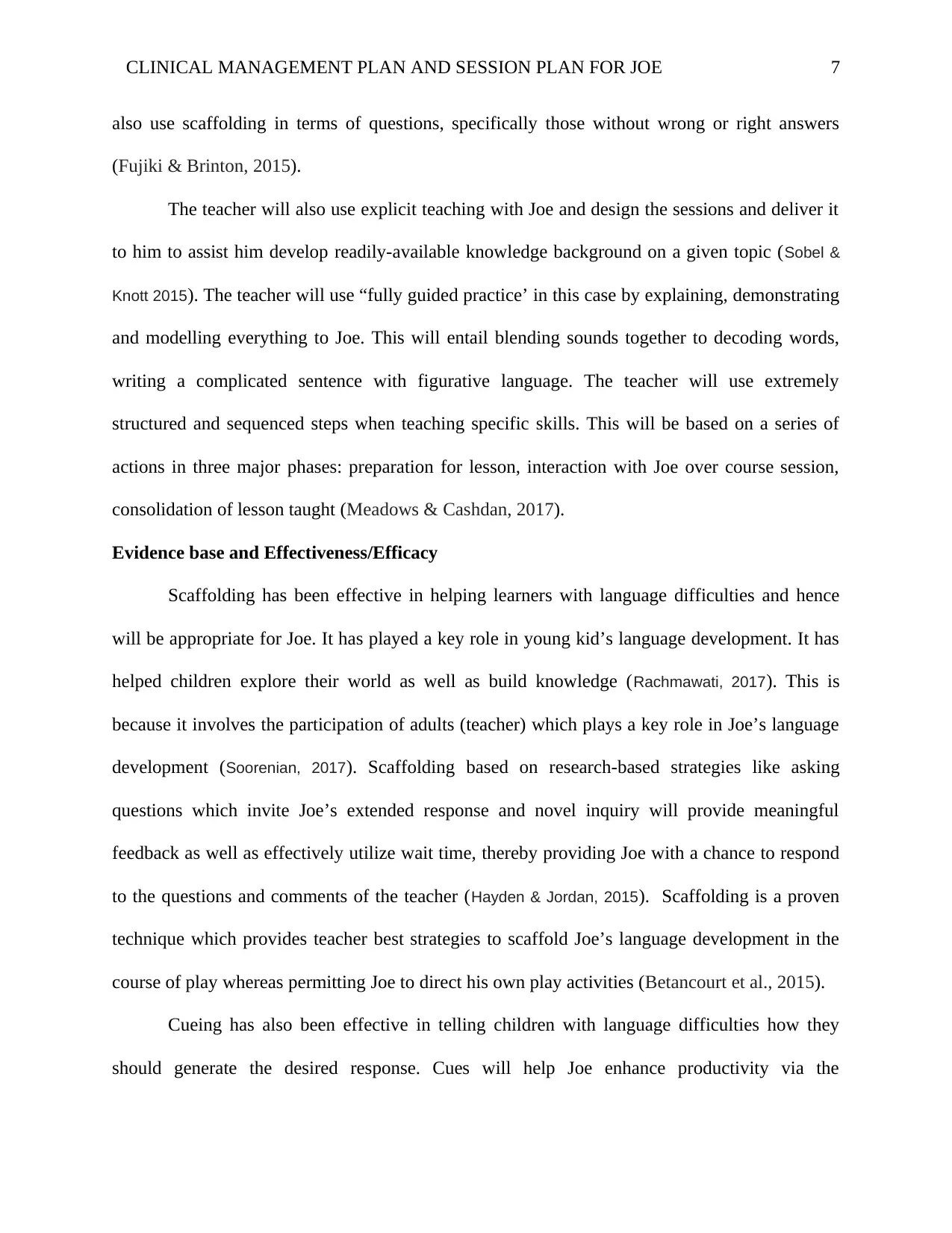
CLINICAL MANAGEMENT PLAN AND SESSION PLAN FOR JOE 7
also use scaffolding in terms of questions, specifically those without wrong or right answers
(Fujiki & Brinton, 2015).
The teacher will also use explicit teaching with Joe and design the sessions and deliver it
to him to assist him develop readily-available knowledge background on a given topic (Sobel &
Knott 2015). The teacher will use “fully guided practice’ in this case by explaining, demonstrating
and modelling everything to Joe. This will entail blending sounds together to decoding words,
writing a complicated sentence with figurative language. The teacher will use extremely
structured and sequenced steps when teaching specific skills. This will be based on a series of
actions in three major phases: preparation for lesson, interaction with Joe over course session,
consolidation of lesson taught (Meadows & Cashdan, 2017).
Evidence base and Effectiveness/Efficacy
Scaffolding has been effective in helping learners with language difficulties and hence
will be appropriate for Joe. It has played a key role in young kid’s language development. It has
helped children explore their world as well as build knowledge (Rachmawati, 2017). This is
because it involves the participation of adults (teacher) which plays a key role in Joe’s language
development (Soorenian, 2017). Scaffolding based on research-based strategies like asking
questions which invite Joe’s extended response and novel inquiry will provide meaningful
feedback as well as effectively utilize wait time, thereby providing Joe with a chance to respond
to the questions and comments of the teacher (Hayden & Jordan, 2015). Scaffolding is a proven
technique which provides teacher best strategies to scaffold Joe’s language development in the
course of play whereas permitting Joe to direct his own play activities (Betancourt et al., 2015).
Cueing has also been effective in telling children with language difficulties how they
should generate the desired response. Cues will help Joe enhance productivity via the
also use scaffolding in terms of questions, specifically those without wrong or right answers
(Fujiki & Brinton, 2015).
The teacher will also use explicit teaching with Joe and design the sessions and deliver it
to him to assist him develop readily-available knowledge background on a given topic (Sobel &
Knott 2015). The teacher will use “fully guided practice’ in this case by explaining, demonstrating
and modelling everything to Joe. This will entail blending sounds together to decoding words,
writing a complicated sentence with figurative language. The teacher will use extremely
structured and sequenced steps when teaching specific skills. This will be based on a series of
actions in three major phases: preparation for lesson, interaction with Joe over course session,
consolidation of lesson taught (Meadows & Cashdan, 2017).
Evidence base and Effectiveness/Efficacy
Scaffolding has been effective in helping learners with language difficulties and hence
will be appropriate for Joe. It has played a key role in young kid’s language development. It has
helped children explore their world as well as build knowledge (Rachmawati, 2017). This is
because it involves the participation of adults (teacher) which plays a key role in Joe’s language
development (Soorenian, 2017). Scaffolding based on research-based strategies like asking
questions which invite Joe’s extended response and novel inquiry will provide meaningful
feedback as well as effectively utilize wait time, thereby providing Joe with a chance to respond
to the questions and comments of the teacher (Hayden & Jordan, 2015). Scaffolding is a proven
technique which provides teacher best strategies to scaffold Joe’s language development in the
course of play whereas permitting Joe to direct his own play activities (Betancourt et al., 2015).
Cueing has also been effective in telling children with language difficulties how they
should generate the desired response. Cues will help Joe enhance productivity via the
Paraphrase This Document
Need a fresh take? Get an instant paraphrase of this document with our AI Paraphraser
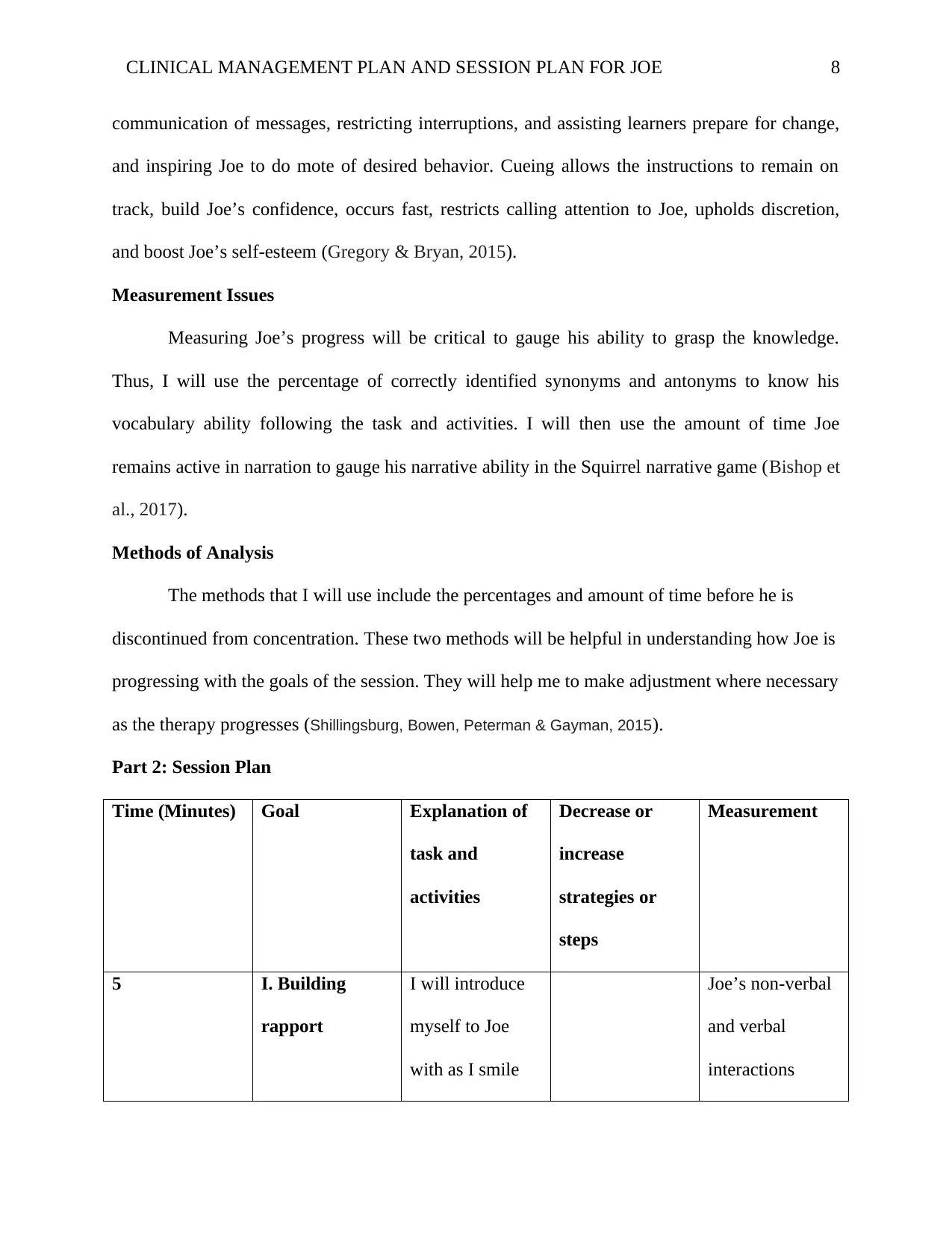
CLINICAL MANAGEMENT PLAN AND SESSION PLAN FOR JOE 8
communication of messages, restricting interruptions, and assisting learners prepare for change,
and inspiring Joe to do mote of desired behavior. Cueing allows the instructions to remain on
track, build Joe’s confidence, occurs fast, restricts calling attention to Joe, upholds discretion,
and boost Joe’s self-esteem (Gregory & Bryan, 2015).
Measurement Issues
Measuring Joe’s progress will be critical to gauge his ability to grasp the knowledge.
Thus, I will use the percentage of correctly identified synonyms and antonyms to know his
vocabulary ability following the task and activities. I will then use the amount of time Joe
remains active in narration to gauge his narrative ability in the Squirrel narrative game (Bishop et
al., 2017).
Methods of Analysis
The methods that I will use include the percentages and amount of time before he is
discontinued from concentration. These two methods will be helpful in understanding how Joe is
progressing with the goals of the session. They will help me to make adjustment where necessary
as the therapy progresses (Shillingsburg, Bowen, Peterman & Gayman, 2015).
Part 2: Session Plan
Time (Minutes) Goal Explanation of
task and
activities
Decrease or
increase
strategies or
steps
Measurement
5 I. Building
rapport
I will introduce
myself to Joe
with as I smile
Joe’s non-verbal
and verbal
interactions
communication of messages, restricting interruptions, and assisting learners prepare for change,
and inspiring Joe to do mote of desired behavior. Cueing allows the instructions to remain on
track, build Joe’s confidence, occurs fast, restricts calling attention to Joe, upholds discretion,
and boost Joe’s self-esteem (Gregory & Bryan, 2015).
Measurement Issues
Measuring Joe’s progress will be critical to gauge his ability to grasp the knowledge.
Thus, I will use the percentage of correctly identified synonyms and antonyms to know his
vocabulary ability following the task and activities. I will then use the amount of time Joe
remains active in narration to gauge his narrative ability in the Squirrel narrative game (Bishop et
al., 2017).
Methods of Analysis
The methods that I will use include the percentages and amount of time before he is
discontinued from concentration. These two methods will be helpful in understanding how Joe is
progressing with the goals of the session. They will help me to make adjustment where necessary
as the therapy progresses (Shillingsburg, Bowen, Peterman & Gayman, 2015).
Part 2: Session Plan
Time (Minutes) Goal Explanation of
task and
activities
Decrease or
increase
strategies or
steps
Measurement
5 I. Building
rapport
I will introduce
myself to Joe
with as I smile
Joe’s non-verbal
and verbal
interactions
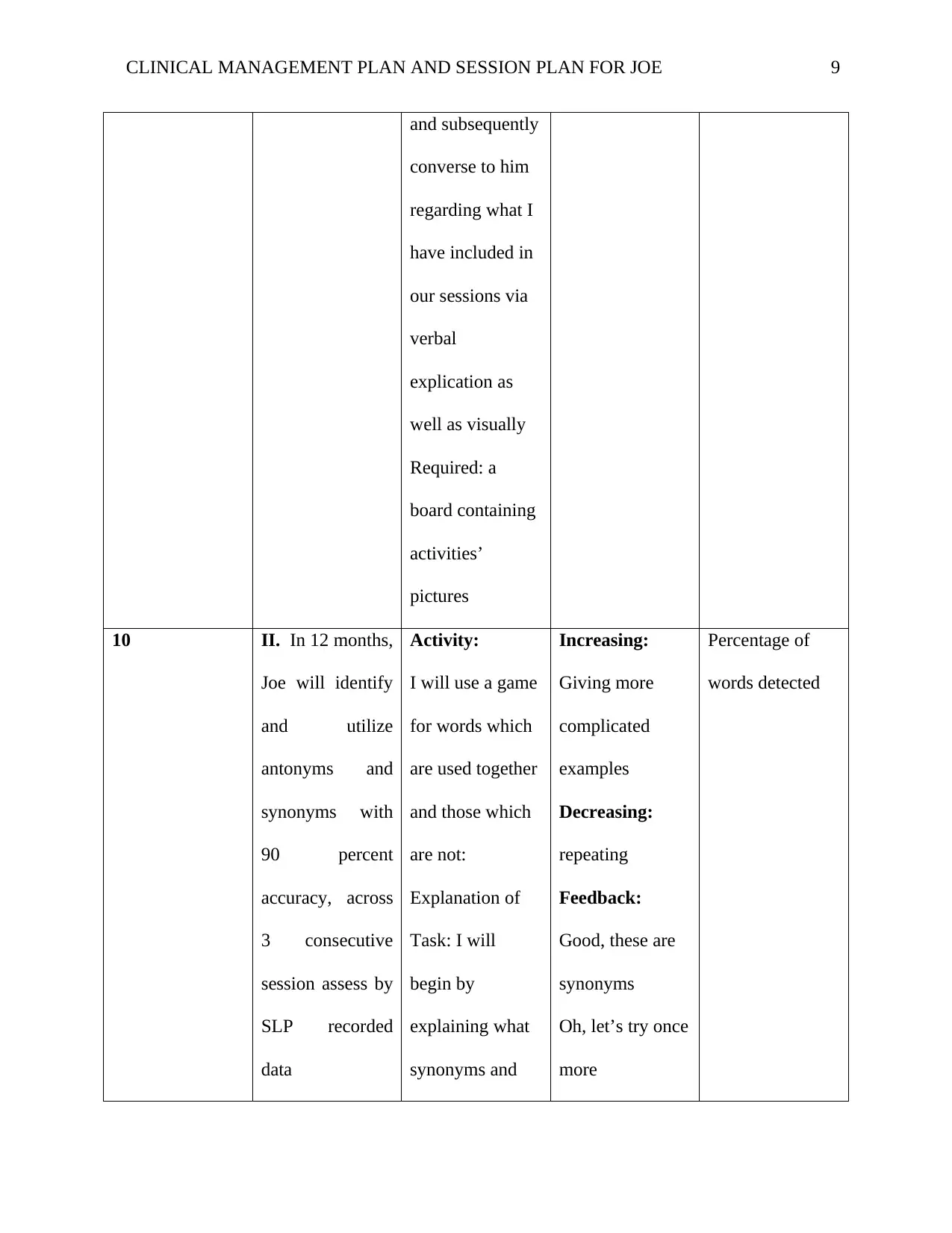
CLINICAL MANAGEMENT PLAN AND SESSION PLAN FOR JOE 9
and subsequently
converse to him
regarding what I
have included in
our sessions via
verbal
explication as
well as visually
Required: a
board containing
activities’
pictures
10 II. In 12 months,
Joe will identify
and utilize
antonyms and
synonyms with
90 percent
accuracy, across
3 consecutive
session assess by
SLP recorded
data
Activity:
I will use a game
for words which
are used together
and those which
are not:
Explanation of
Task: I will
begin by
explaining what
synonyms and
Increasing:
Giving more
complicated
examples
Decreasing:
repeating
Feedback:
Good, these are
synonyms
Oh, let’s try once
more
Percentage of
words detected
and subsequently
converse to him
regarding what I
have included in
our sessions via
verbal
explication as
well as visually
Required: a
board containing
activities’
pictures
10 II. In 12 months,
Joe will identify
and utilize
antonyms and
synonyms with
90 percent
accuracy, across
3 consecutive
session assess by
SLP recorded
data
Activity:
I will use a game
for words which
are used together
and those which
are not:
Explanation of
Task: I will
begin by
explaining what
synonyms and
Increasing:
Giving more
complicated
examples
Decreasing:
repeating
Feedback:
Good, these are
synonyms
Oh, let’s try once
more
Percentage of
words detected
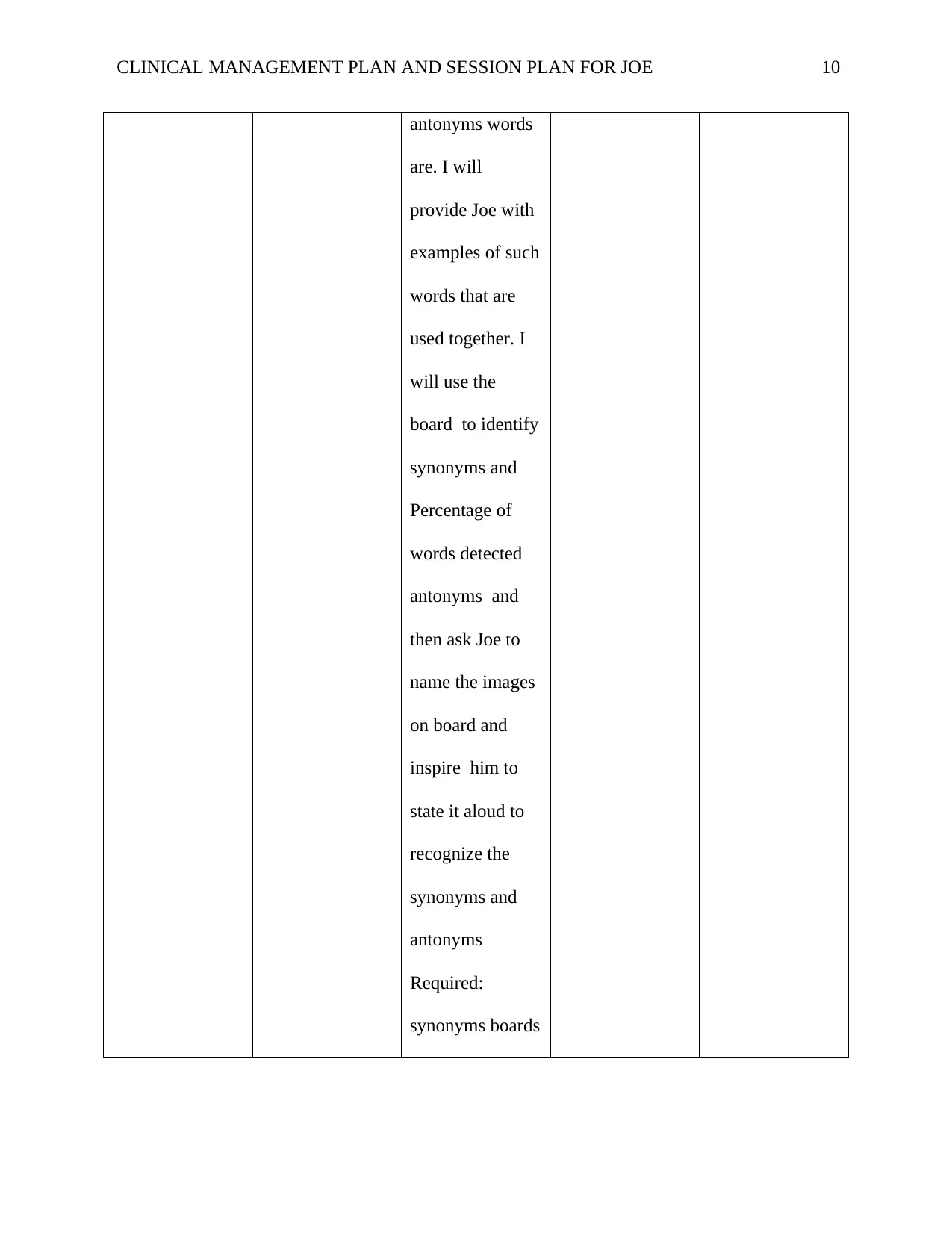
CLINICAL MANAGEMENT PLAN AND SESSION PLAN FOR JOE 10
antonyms words
are. I will
provide Joe with
examples of such
words that are
used together. I
will use the
board to identify
synonyms and
Percentage of
words detected
antonyms and
then ask Joe to
name the images
on board and
inspire him to
state it aloud to
recognize the
synonyms and
antonyms
Required:
synonyms boards
antonyms words
are. I will
provide Joe with
examples of such
words that are
used together. I
will use the
board to identify
synonyms and
Percentage of
words detected
antonyms and
then ask Joe to
name the images
on board and
inspire him to
state it aloud to
recognize the
synonyms and
antonyms
Required:
synonyms boards
Secure Best Marks with AI Grader
Need help grading? Try our AI Grader for instant feedback on your assignments.
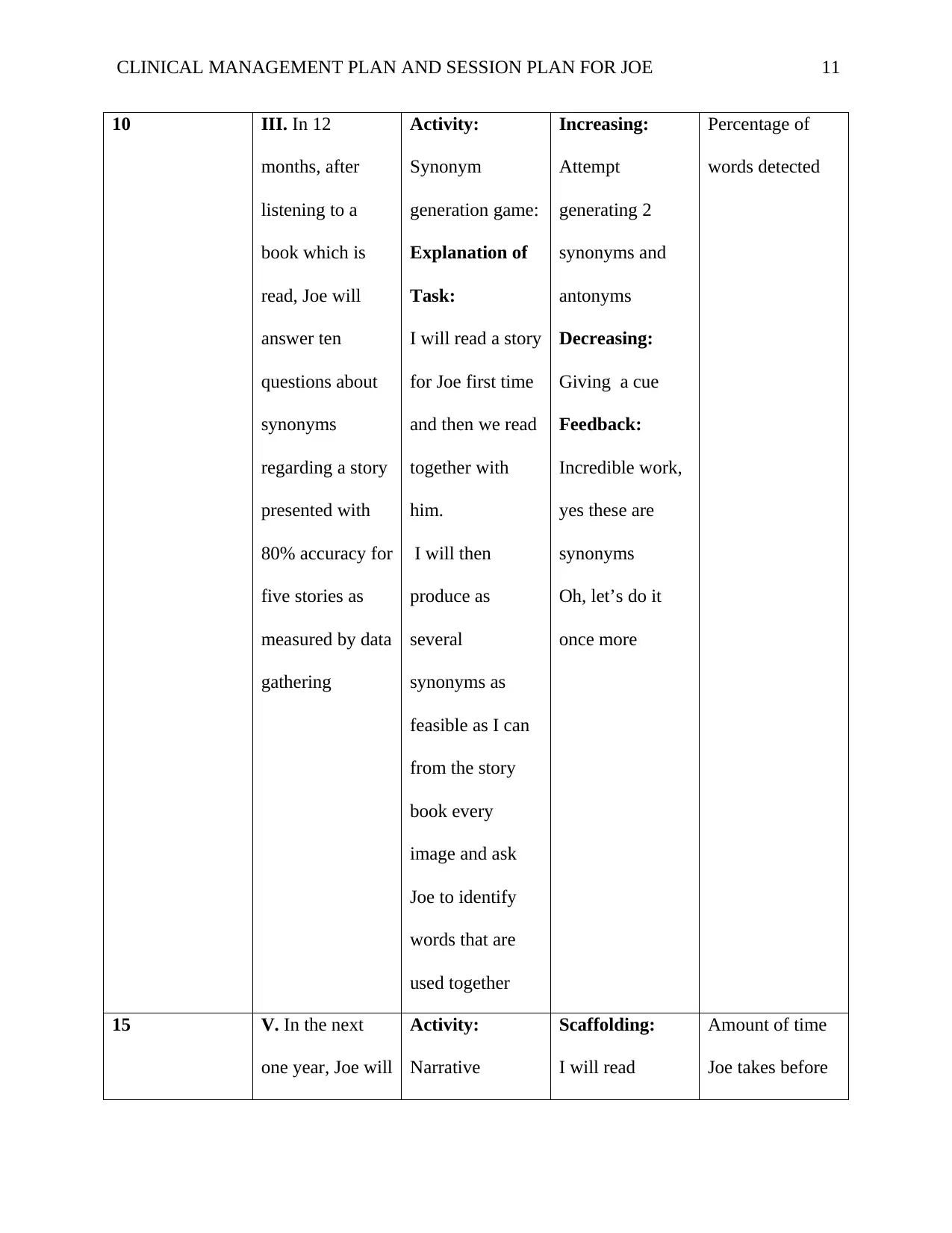
CLINICAL MANAGEMENT PLAN AND SESSION PLAN FOR JOE 11
10 III. In 12
months, after
listening to a
book which is
read, Joe will
answer ten
questions about
synonyms
regarding a story
presented with
80% accuracy for
five stories as
measured by data
gathering
Activity:
Synonym
generation game:
Explanation of
Task:
I will read a story
for Joe first time
and then we read
together with
him.
I will then
produce as
several
synonyms as
feasible as I can
from the story
book every
image and ask
Joe to identify
words that are
used together
Increasing:
Attempt
generating 2
synonyms and
antonyms
Decreasing:
Giving a cue
Feedback:
Incredible work,
yes these are
synonyms
Oh, let’s do it
once more
Percentage of
words detected
15 V. In the next
one year, Joe will
Activity:
Narrative
Scaffolding:
I will read
Amount of time
Joe takes before
10 III. In 12
months, after
listening to a
book which is
read, Joe will
answer ten
questions about
synonyms
regarding a story
presented with
80% accuracy for
five stories as
measured by data
gathering
Activity:
Synonym
generation game:
Explanation of
Task:
I will read a story
for Joe first time
and then we read
together with
him.
I will then
produce as
several
synonyms as
feasible as I can
from the story
book every
image and ask
Joe to identify
words that are
used together
Increasing:
Attempt
generating 2
synonyms and
antonyms
Decreasing:
Giving a cue
Feedback:
Incredible work,
yes these are
synonyms
Oh, let’s do it
once more
Percentage of
words detected
15 V. In the next
one year, Joe will
Activity:
Narrative
Scaffolding:
I will read
Amount of time
Joe takes before
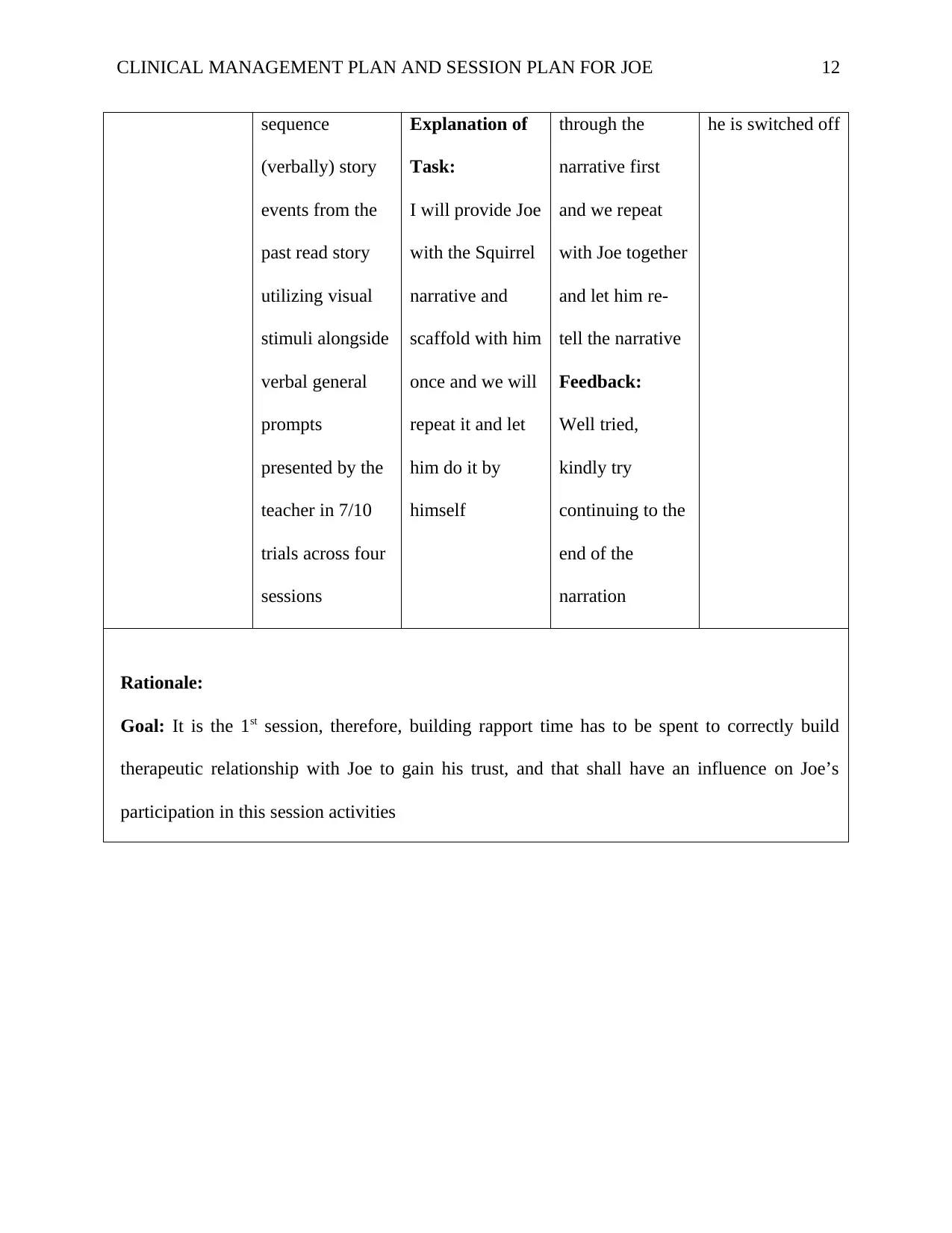
CLINICAL MANAGEMENT PLAN AND SESSION PLAN FOR JOE 12
sequence
(verbally) story
events from the
past read story
utilizing visual
stimuli alongside
verbal general
prompts
presented by the
teacher in 7/10
trials across four
sessions
Explanation of
Task:
I will provide Joe
with the Squirrel
narrative and
scaffold with him
once and we will
repeat it and let
him do it by
himself
through the
narrative first
and we repeat
with Joe together
and let him re-
tell the narrative
Feedback:
Well tried,
kindly try
continuing to the
end of the
narration
he is switched off
Rationale:
Goal: It is the 1st session, therefore, building rapport time has to be spent to correctly build
therapeutic relationship with Joe to gain his trust, and that shall have an influence on Joe’s
participation in this session activities
sequence
(verbally) story
events from the
past read story
utilizing visual
stimuli alongside
verbal general
prompts
presented by the
teacher in 7/10
trials across four
sessions
Explanation of
Task:
I will provide Joe
with the Squirrel
narrative and
scaffold with him
once and we will
repeat it and let
him do it by
himself
through the
narrative first
and we repeat
with Joe together
and let him re-
tell the narrative
Feedback:
Well tried,
kindly try
continuing to the
end of the
narration
he is switched off
Rationale:
Goal: It is the 1st session, therefore, building rapport time has to be spent to correctly build
therapeutic relationship with Joe to gain his trust, and that shall have an influence on Joe’s
participation in this session activities
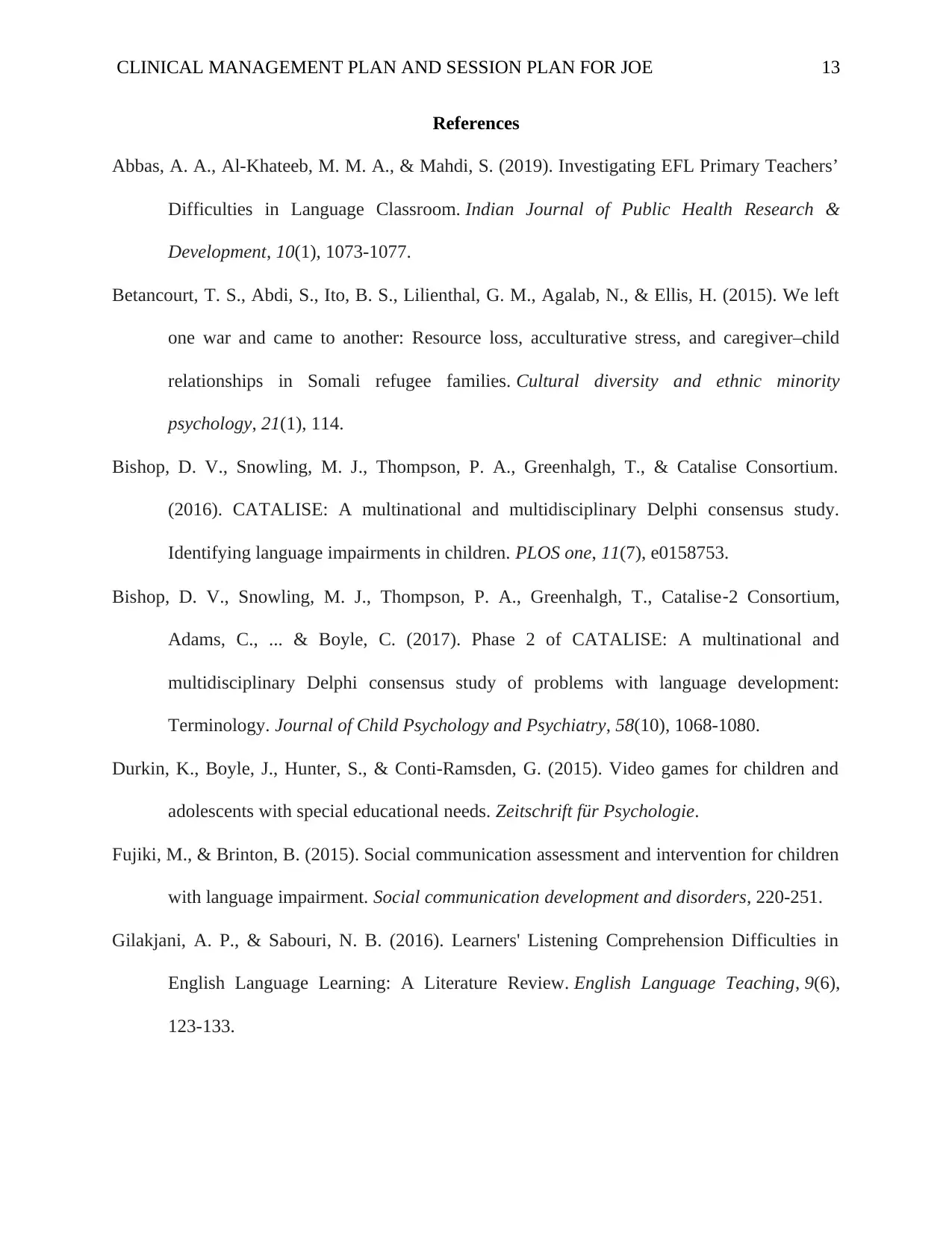
CLINICAL MANAGEMENT PLAN AND SESSION PLAN FOR JOE 13
References
Abbas, A. A., Al-Khateeb, M. M. A., & Mahdi, S. (2019). Investigating EFL Primary Teachers’
Difficulties in Language Classroom. Indian Journal of Public Health Research &
Development, 10(1), 1073-1077.
Betancourt, T. S., Abdi, S., Ito, B. S., Lilienthal, G. M., Agalab, N., & Ellis, H. (2015). We left
one war and came to another: Resource loss, acculturative stress, and caregiver–child
relationships in Somali refugee families. Cultural diversity and ethnic minority
psychology, 21(1), 114.
Bishop, D. V., Snowling, M. J., Thompson, P. A., Greenhalgh, T., & Catalise Consortium.
(2016). CATALISE: A multinational and multidisciplinary Delphi consensus study.
Identifying language impairments in children. PLOS one, 11(7), e0158753.
Bishop, D. V., Snowling, M. J., Thompson, P. A., Greenhalgh, T., Catalise‐2 Consortium,
Adams, C., ... & Boyle, C. (2017). Phase 2 of CATALISE: A multinational and
multidisciplinary Delphi consensus study of problems with language development:
Terminology. Journal of Child Psychology and Psychiatry, 58(10), 1068-1080.
Durkin, K., Boyle, J., Hunter, S., & Conti-Ramsden, G. (2015). Video games for children and
adolescents with special educational needs. Zeitschrift für Psychologie.
Fujiki, M., & Brinton, B. (2015). Social communication assessment and intervention for children
with language impairment. Social communication development and disorders, 220-251.
Gilakjani, A. P., & Sabouri, N. B. (2016). Learners' Listening Comprehension Difficulties in
English Language Learning: A Literature Review. English Language Teaching, 9(6),
123-133.
References
Abbas, A. A., Al-Khateeb, M. M. A., & Mahdi, S. (2019). Investigating EFL Primary Teachers’
Difficulties in Language Classroom. Indian Journal of Public Health Research &
Development, 10(1), 1073-1077.
Betancourt, T. S., Abdi, S., Ito, B. S., Lilienthal, G. M., Agalab, N., & Ellis, H. (2015). We left
one war and came to another: Resource loss, acculturative stress, and caregiver–child
relationships in Somali refugee families. Cultural diversity and ethnic minority
psychology, 21(1), 114.
Bishop, D. V., Snowling, M. J., Thompson, P. A., Greenhalgh, T., & Catalise Consortium.
(2016). CATALISE: A multinational and multidisciplinary Delphi consensus study.
Identifying language impairments in children. PLOS one, 11(7), e0158753.
Bishop, D. V., Snowling, M. J., Thompson, P. A., Greenhalgh, T., Catalise‐2 Consortium,
Adams, C., ... & Boyle, C. (2017). Phase 2 of CATALISE: A multinational and
multidisciplinary Delphi consensus study of problems with language development:
Terminology. Journal of Child Psychology and Psychiatry, 58(10), 1068-1080.
Durkin, K., Boyle, J., Hunter, S., & Conti-Ramsden, G. (2015). Video games for children and
adolescents with special educational needs. Zeitschrift für Psychologie.
Fujiki, M., & Brinton, B. (2015). Social communication assessment and intervention for children
with language impairment. Social communication development and disorders, 220-251.
Gilakjani, A. P., & Sabouri, N. B. (2016). Learners' Listening Comprehension Difficulties in
English Language Learning: A Literature Review. English Language Teaching, 9(6),
123-133.
Paraphrase This Document
Need a fresh take? Get an instant paraphrase of this document with our AI Paraphraser
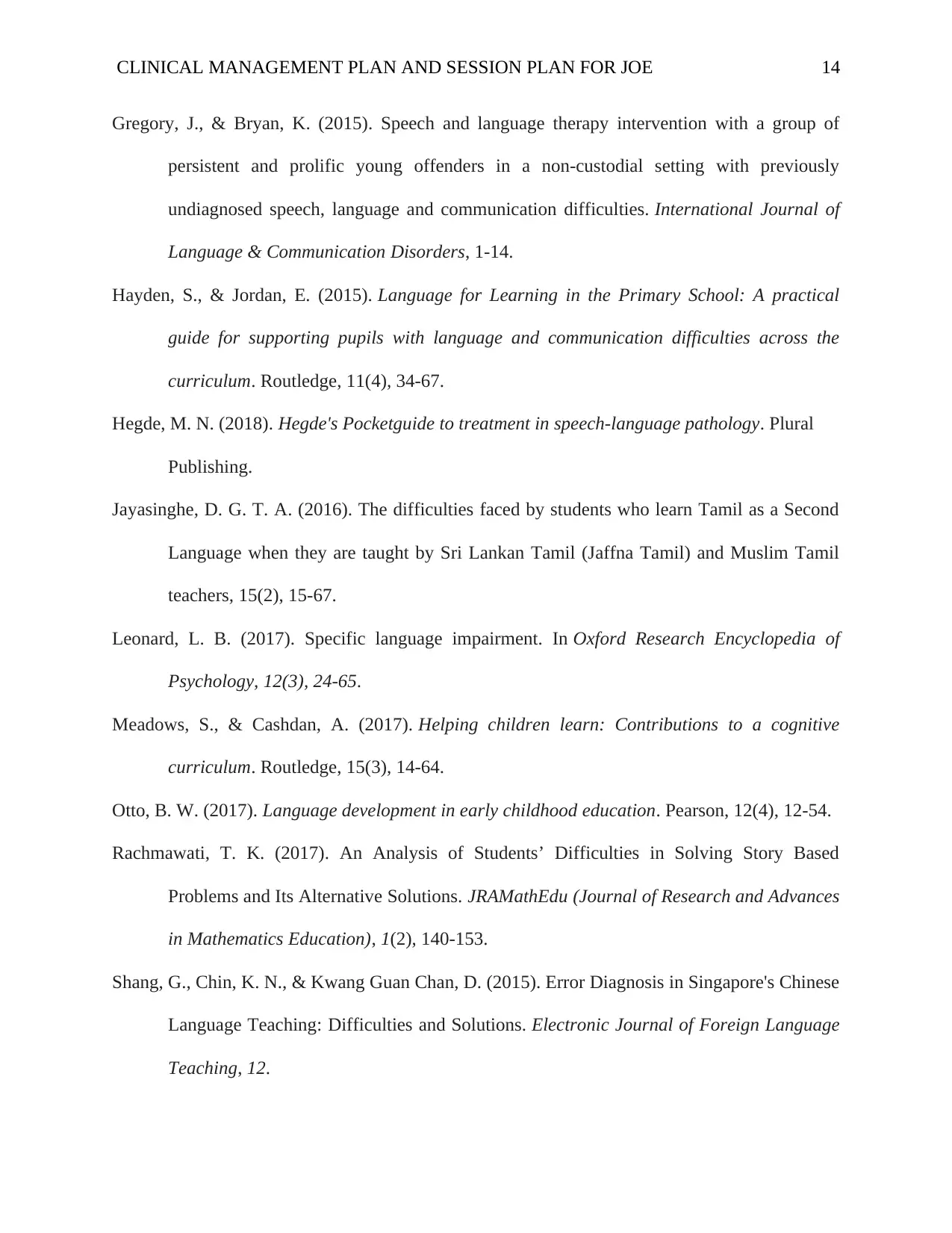
CLINICAL MANAGEMENT PLAN AND SESSION PLAN FOR JOE 14
Gregory, J., & Bryan, K. (2015). Speech and language therapy intervention with a group of
persistent and prolific young offenders in a non-custodial setting with previously
undiagnosed speech, language and communication difficulties. International Journal of
Language & Communication Disorders, 1-14.
Hayden, S., & Jordan, E. (2015). Language for Learning in the Primary School: A practical
guide for supporting pupils with language and communication difficulties across the
curriculum. Routledge, 11(4), 34-67.
Hegde, M. N. (2018). Hegde's Pocketguide to treatment in speech-language pathology. Plural
Publishing.
Jayasinghe, D. G. T. A. (2016). The difficulties faced by students who learn Tamil as a Second
Language when they are taught by Sri Lankan Tamil (Jaffna Tamil) and Muslim Tamil
teachers, 15(2), 15-67.
Leonard, L. B. (2017). Specific language impairment. In Oxford Research Encyclopedia of
Psychology, 12(3), 24-65.
Meadows, S., & Cashdan, A. (2017). Helping children learn: Contributions to a cognitive
curriculum. Routledge, 15(3), 14-64.
Otto, B. W. (2017). Language development in early childhood education. Pearson, 12(4), 12-54.
Rachmawati, T. K. (2017). An Analysis of Students’ Difficulties in Solving Story Based
Problems and Its Alternative Solutions. JRAMathEdu (Journal of Research and Advances
in Mathematics Education), 1(2), 140-153.
Shang, G., Chin, K. N., & Kwang Guan Chan, D. (2015). Error Diagnosis in Singapore's Chinese
Language Teaching: Difficulties and Solutions. Electronic Journal of Foreign Language
Teaching, 12.
Gregory, J., & Bryan, K. (2015). Speech and language therapy intervention with a group of
persistent and prolific young offenders in a non-custodial setting with previously
undiagnosed speech, language and communication difficulties. International Journal of
Language & Communication Disorders, 1-14.
Hayden, S., & Jordan, E. (2015). Language for Learning in the Primary School: A practical
guide for supporting pupils with language and communication difficulties across the
curriculum. Routledge, 11(4), 34-67.
Hegde, M. N. (2018). Hegde's Pocketguide to treatment in speech-language pathology. Plural
Publishing.
Jayasinghe, D. G. T. A. (2016). The difficulties faced by students who learn Tamil as a Second
Language when they are taught by Sri Lankan Tamil (Jaffna Tamil) and Muslim Tamil
teachers, 15(2), 15-67.
Leonard, L. B. (2017). Specific language impairment. In Oxford Research Encyclopedia of
Psychology, 12(3), 24-65.
Meadows, S., & Cashdan, A. (2017). Helping children learn: Contributions to a cognitive
curriculum. Routledge, 15(3), 14-64.
Otto, B. W. (2017). Language development in early childhood education. Pearson, 12(4), 12-54.
Rachmawati, T. K. (2017). An Analysis of Students’ Difficulties in Solving Story Based
Problems and Its Alternative Solutions. JRAMathEdu (Journal of Research and Advances
in Mathematics Education), 1(2), 140-153.
Shang, G., Chin, K. N., & Kwang Guan Chan, D. (2015). Error Diagnosis in Singapore's Chinese
Language Teaching: Difficulties and Solutions. Electronic Journal of Foreign Language
Teaching, 12.
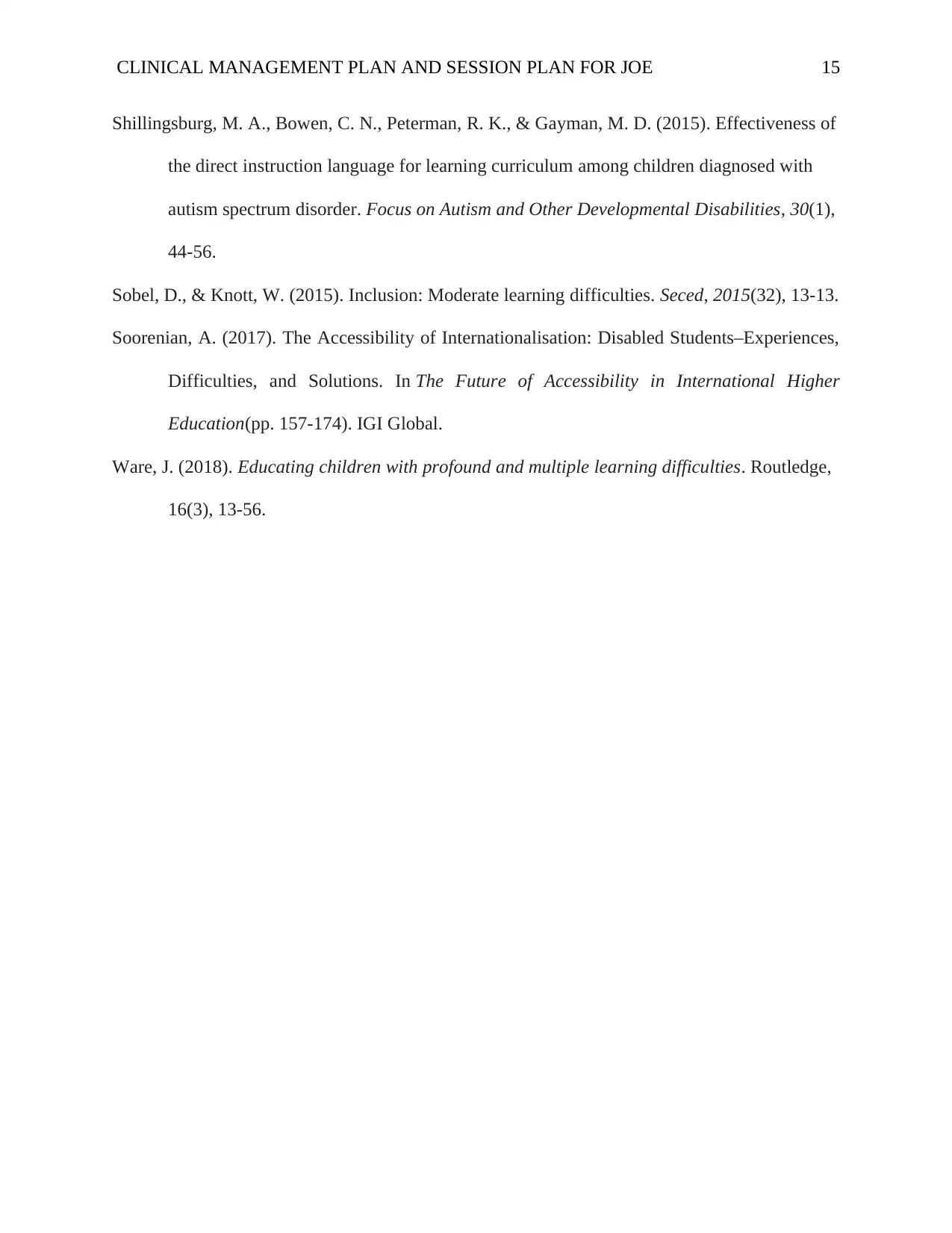
CLINICAL MANAGEMENT PLAN AND SESSION PLAN FOR JOE 15
Shillingsburg, M. A., Bowen, C. N., Peterman, R. K., & Gayman, M. D. (2015). Effectiveness of
the direct instruction language for learning curriculum among children diagnosed with
autism spectrum disorder. Focus on Autism and Other Developmental Disabilities, 30(1),
44-56.
Sobel, D., & Knott, W. (2015). Inclusion: Moderate learning difficulties. Seced, 2015(32), 13-13.
Soorenian, A. (2017). The Accessibility of Internationalisation: Disabled Students–Experiences,
Difficulties, and Solutions. In The Future of Accessibility in International Higher
Education(pp. 157-174). IGI Global.
Ware, J. (2018). Educating children with profound and multiple learning difficulties. Routledge,
16(3), 13-56.
Shillingsburg, M. A., Bowen, C. N., Peterman, R. K., & Gayman, M. D. (2015). Effectiveness of
the direct instruction language for learning curriculum among children diagnosed with
autism spectrum disorder. Focus on Autism and Other Developmental Disabilities, 30(1),
44-56.
Sobel, D., & Knott, W. (2015). Inclusion: Moderate learning difficulties. Seced, 2015(32), 13-13.
Soorenian, A. (2017). The Accessibility of Internationalisation: Disabled Students–Experiences,
Difficulties, and Solutions. In The Future of Accessibility in International Higher
Education(pp. 157-174). IGI Global.
Ware, J. (2018). Educating children with profound and multiple learning difficulties. Routledge,
16(3), 13-56.
1 out of 15
Related Documents
Your All-in-One AI-Powered Toolkit for Academic Success.
+13062052269
info@desklib.com
Available 24*7 on WhatsApp / Email
![[object Object]](/_next/static/media/star-bottom.7253800d.svg)
Unlock your academic potential
© 2024 | Zucol Services PVT LTD | All rights reserved.
